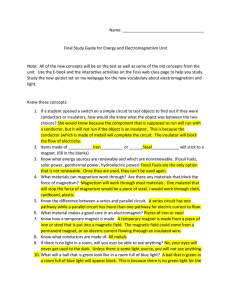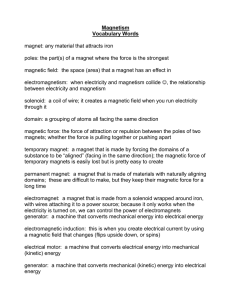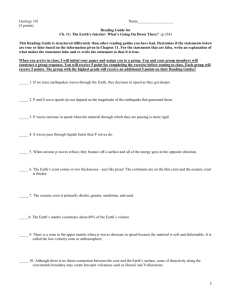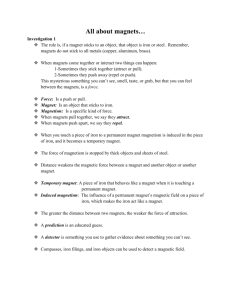PHY1033C/HIS3931/IDH 3931 : Discovering Physics: Prof. Peter Hirschfeld, Physics Fall 2015
advertisement
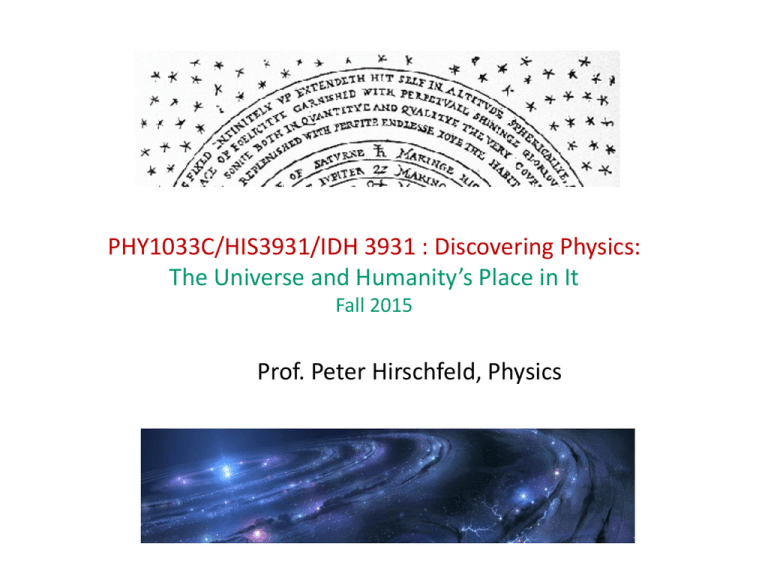
PHY1033C/HIS3931/IDH 3931 : Discovering Physics: The Universe and Humanity’s Place in It Fall 2015 Prof. Peter Hirschfeld, Physics Announcements • HW 7 due today HW8 posted, due Nov. 10 • Reading: Chapter 16, pp. 331-39; Chapter 20, pp. 411-18, 425-29, 431-33 • Thurs., Nov. 12 4pm after class, NPB 2165: Optional film: Relativity pizza party! • HW 6 remark: acceleration due to gravity HW6 comments y vy=0 ay=-10m/s2 down v a=Dv/Dt = -10m/s2 a=Dv/Dt = -10m/s2 a=Dv/Dt = -10m/s2 a=Dv/Dt =t -10m/ x At top of trajectory, v=0 but a=-10 m/s2 Newton’s cannon Last time • Momentum conservation: every particle has its own mv (Descartes’ “force of motion”). Sum of all all such momenta is conserved if there is no external force. • Energy conservation (1st law of thermodynamics): there is a quantity called energy which exists in various forms, but is always conserved, although its form can be changed. • Mechanical energy consists of kinetic energy (Leibniz’ vis viva), just ½ mv2 per particle, plus potential energy (Helmholz’s “tensive force”) which depends on the position of the particle. For example, gravitational potential energy, mgh, depends on the particle’s height h above the Earth’s surface. Last time • Other types of energy: chemical, nuclear, electromagnetic… • Work: applying an external force F acting through a distance d produces work Fd in the form of mechanical energy, heat, …etc • Crucial ideas about energy and heat: Carnot: can only operate a heat engine between two different temperatures. Joule: “equivalence” of mechanical work and heat Clausius: heat cannot be completely turned into useful mechanical work • 2nd law of thermodynamics: entropy (disorder, randomness) always increases • Kelvin: total ability to do useful work must decrease to zero as universe evolves to a constant temperature “Heat death” of universe is our fate Clicker question When the Apollo astronauts were on the moon, they did not fall off because A) B) C) D) E) The Earth’s gravity extends to the moon They wore safety ropes They had heavy boots The moon has its own gravity The moon is in orbit Electricity and magnetism Where do you see electricity and magnetism in nature? Rub a balloon or plastic rod, find they can attract or repel other objects, or stick to surfaces : "static electricity" – what is it really? Lightning is “electricity” – but what is it? Bar magnet on refrigerator – why does it stick? …and what, if anything, do these things have to do with each other? The Greeks knew that if you rubbed a piece of amber you could pick up little pieces of papyrus. They knew about a kind of rock, later called lodestone, which would attract iron. And they had seen lightning. It took twenty centuries before an understanding of the connections among these effects came about, in France, Britain, and the United States. In intellectual terms, relating such apparently diverse phenomena under one theory was comparable to Newton's idea that the force which attracted the apple to the earth and the earth to the moon were one and the same. Two types of electrical charge (Franklin) Demo: electroscope: charging by induction! Charles Augustin de Coulomb (1736-1806) Force between two point electric charges: Coulomb’s law (C. Coulomb, 17th cent.) r q1 q1q2 F k 2 r q2 where k=9x109 N m2/C2 Can be repulsive (q1 q2 > 0) or attractive (q1 q2 < 0) Also: gravity is incredibly weak compared to EM force! (see HW!) Q: if electric force is strong, F ~ 1/r2 why are effects so well hidden? Effects of gravity are observed by us in star systems light years from us, yet effects of EM force are hard to find in our own back yard. Why? A: Fundamental difference between gravity and EM force: gravity is only attractive, EM can be attractive or repulsive. Atoms are neutral. History of magnetism 800 B.C. First Greek writings about "lodestone" Lodestone-magnetic iron ore FeO-Fe2O3. Name magnet comes either from origin in Greek province of Magnesia, or (Pliny) from name Magnes of shepherd "the nails of whose shoes and the tip of whose staff stuck fast in a magnetick field while he pastured his flocks." 800 B.C. - 0 A.D. Early theories of magnetism: 1) magnet "feeds on" iron; 2) magnet emits "effluvia"-invisible objects or fluid. History of magnetism (cont’d) • Diogenes of Apollonia (460 B.C.): Iron contains humidity which dryness of magnet feeds upon • "First, from the magnet num'rous Parts arise. And swiftly move; the Stone gives vast supplies; Which, springing still in Constant Stream, displace The Neighb'ring air and make an empty Space; So when the Steel comes there, some Parts begin To leap on through the void and enter in... The Steel will move to seek the Stone' s embrace, Or up or down, or t'any other place Which way soever lies the empty Space. -Lucretius Carus, Roman poet. History of magnetism (cont’d) 100 A.D. China Invention of Compass Known in Europe only by 12th century A.D. magnetized spoon on plate Immediately found use in Europe as navigational device, unlike China, where it remained largely a curiosity. floating magnetic fish 1040 A.D. History of magnetism (cont’d) 1269 A.D. Poles of magnet discovered. Petrus Peregrinus - wrote first treatise on exp’tl magnetism. Put iron filings in various places around spherical lodestone, mapped out orientations and noticed streamlines converged at N and S poles. 1600 Publication of de Magnete by William Gilbert • Repeated Peregrinus' experiments, great exponent of experimental method. • Disproved superstitions saying garlic, onion, and diamonds could rob magnets of their power. • Recognized that earth itself was a magnet, and that magnetic poles did not quite coincide with real poles. History of magnetism (cont’d) "A man offered to sell me a secret for permitting one to speak, through the attraction of a certain magnet needle, to someone distant two or three thousand miles, and I said to him that I would be willing to purchase it, but that I would like to witness a trial of it, and that it would please me to test it, I being in one room and he in another. He told me that, at such short distance, the action could not be witnessed to advantage; so I sent him away, and said that I could not go just then to Egypt or Muscovy to see his experiment, but that if he would go there himself, I would stay and attend to the rest in Venice." Galileo, 1632 History of magnetism (cont’d) John Baptista Porta, 16th century. Experiment burying magnet and iron filings in earth, waiting several months and reweighing to see if magnet had "eaten" the iron. Porta also puts forward classic "romantic" theory of magnetic attraction (1589): "...iron is drawn by the Loadstone, as a bride after the bridegroom, to be embraced; and the iron is so desirous to joyn with it as her husband, and is so sollicitous to meet the Loadstone: when it is hindred by its weight, yet it will stand an end, as if it held up its hands to beg of the stone, and flattering of it.... and shews that it is not content with its condition: but if it once kist the Loadstone, as if the desire were satisfied, it is then at rest; and they are so mutually in love, that if one cannot come to the other, it will hang pendulous in the air ... History of magnetism (cont’d) 1600-1820 Questions about connection between electricity & magnetism 1681, ship struck by lightning has compass reversed. Failed attempts to create 2-fluid theory of magnetism like electricity. Most believe they are distinct phenomena. 1820 Hans Christian Oersted experiment Electric current in wire deflects compass needle nearby. July 1820, description of experiment published in latin. Prof. at U. Copenhagen Magnetism: a “circular” rather than central force =current Oersted influenced by stay in Germany (Jena school of philosophy), in particular, Friedrich Schelling, who considered nature as a “world soul”, resulting from interplay of attractive & repulsive forces. From this standpoint, he expected and was looking for a connection between electricity and magnetism. Reported an effect, “confused” and “feeble”. History of magnetism (cont’d) September 11,1820 Dominique Arago reports Oersted discovery to French Academy of Sciences. Announces own discovery that current in wire acts like ordinary magnet, attracting filings & inducing permanent magnetism in iron needles. September 18, 1820 André Marie Ampère puts forward theory of magnetism due to internal circulating currentsReports experiments indicating force between current-carrying wires is attractive if two wires carry current in same direction, repulsive otherwise. November 6, 1820 Ampère-Arago experiment reporting strong magnetization of needle in coil of wire. November 16,1820 Similar results reported by Sir Humphrey Davy Demo: Ampère: force between two current-carrying wires. “ “ Unlike electric charges, magnetic poles cannot be separated! Magnetic fields Michael Faraday (1781-1867) imagined lines of a “force field” that extended into space around a magnet. The “magnetic field” at a point in space provides a force if a magnet or current is placed there Permanent magnets (e.g. iron) In some materials each atom has a tiny magnetic moment which acts like a tiny bar magnet. These moments like to line up with each other, like bar magnets, but sometimes disorder in the material prevents this, and they only line up in a small portion of the sample, called a magnetic domain. You can’t tell that the material is magnetic inside until you apply a large external field to it, aligning the domains. Then you have a good permanent magnet. The earth is a permanent magnet Circulating electric currents in central core cause: …which is why compasses work
